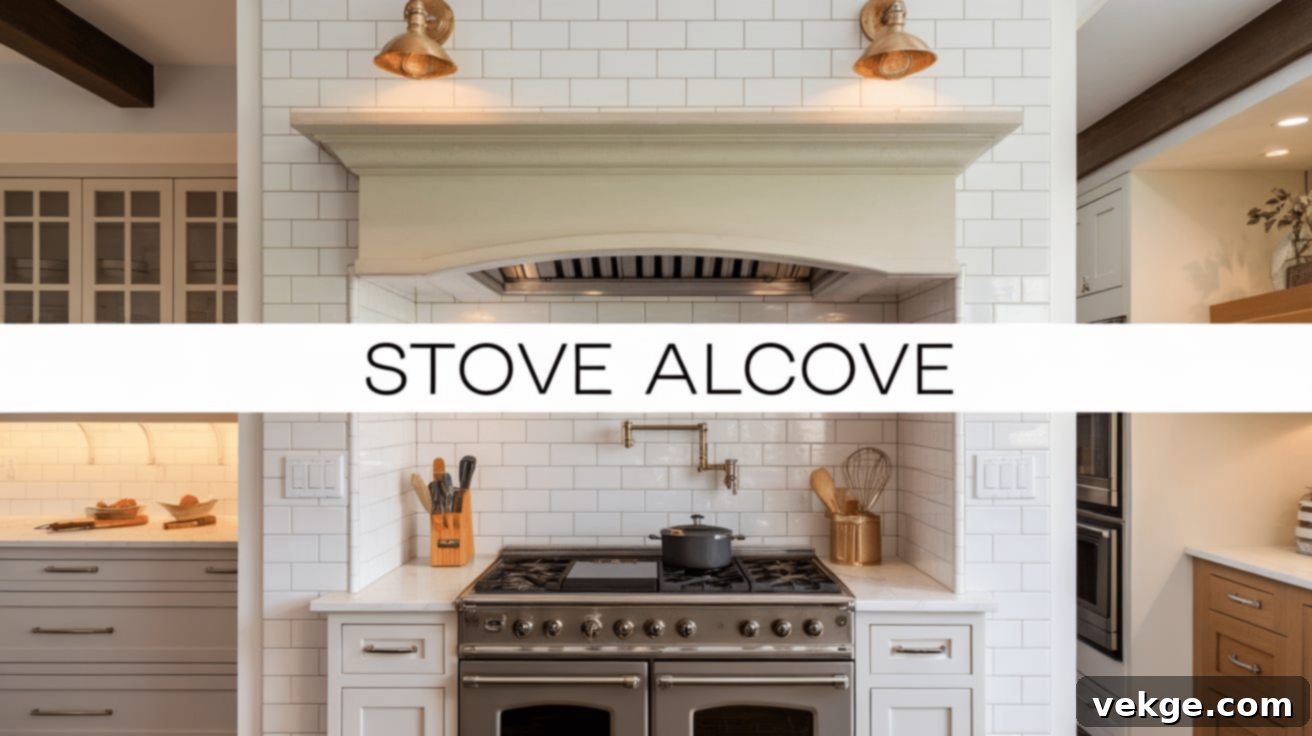Stove Alcoves: The Ultimate Guide to Enhancing Your Kitchen’s Style & Functionality
A stove alcove is more than just a dedicated space for your range; it’s a design element that marries historical charm with modern practicality, significantly elevating the aesthetic and functional appeal of your kitchen. This recessed area, specifically designed to house a stove, not only streamlines your cooking workflow but also transforms a utilitarian appliance into a captivating centerpiece.
Historically, stove alcoves served a crucial purpose, primarily to contain the intense heat from wood-burning stoves and shield surrounding walls from fire. While today’s kitchens feature safer, more efficient appliances, the concept of the stove alcove has resurfaced, celebrated for its ability to create a strong visual statement and offer valuable built-in storage solutions.
Many homeowners are now choosing to integrate stove alcoves to define their kitchen’s character. They provide an ideal opportunity for adding custom shelving for spices, oils, and other cooking essentials, keeping everything conveniently within reach. Whether you envision a rustic, traditional, minimalist, or luxurious kitchen, there’s a stove alcove design that can perfectly complement your style.
In this comprehensive guide, we’ll delve into the myriad benefits of incorporating a stove alcove, explore diverse design ideas, and outline critical considerations to help you plan and execute this stunning addition to your culinary space.
What Exactly is a Stove Alcove in Kitchen Design?
At its core, a stove alcove is a strategically recessed area within the kitchen, purpose-built to perfectly frame and house a cooking range. This architectural feature serves a dual role: it provides a highly organized and efficient cooking zone while simultaneously acting as a powerful decorative element that anchors the kitchen’s design. The alcove can be beautifully defined by various materials such as tile, brick, natural stone, or wood, each contributing to a distinct aesthetic that highlights the stove and often incorporates additional storage options.
The origins of stove alcoves trace back to older homes, particularly those reliant on wood-burning stoves. These early alcoves were essential for safety, designed to concentrate heat, improve combustion efficiency, and protect adjacent kitchen walls from fire hazards and smoke damage. Materials like brick and stone were favored not only for their heat-resistant properties but also for their ability to radiate warmth, contributing to a cozier home environment.
Today, the resurgence of stove alcoves reflects a desire for kitchens that are both highly functional and visually striking. They offer a defined boundary for the stove, creating a more cohesive and less cluttered look. Beyond aesthetics, modern alcoves frequently incorporate clever storage solutions, such as integrated shelving or hidden compartments, for spices, cooking oils, and utensils. For many homeowners, a stove alcove is the chosen method to create a standout focal point, drawing attention to the heart of the kitchen and celebrating the art of cooking while maintaining impeccable organization.
Key Benefits of Integrating a Stove Alcove into Your Kitchen
Incorporating a stove alcove is more than a mere design choice; it’s an investment in enhancing both the functionality and visual appeal of your kitchen. Here are the most compelling advantages of adding this timeless feature to your home.
1. Improved Heat Containment and Wall Protection
One of the enduring practical benefits of a stove alcove is its ability to help manage and contain the heat generated by your stove. While modern stoves are significantly safer than their historical counterparts, an alcove still offers a protective barrier. It minimizes direct heat exposure to nearby cabinets and walls, preventing potential damage, discoloration, or warping of materials over time. This enhanced protection contributes to the longevity of your kitchen’s finishes and structural elements, making it a safer and more durable cooking environment.
2. Enhanced Storage and Organization
A significant advantage of a well-designed stove alcove is the invaluable extra storage it provides. By integrating built-in shelves, recessed nooks, or side compartments, you can keep essential cooking items like spices, oils, vinegars, and frequently used utensils precisely where you need them – within arm’s reach while you cook. This thoughtful placement not only makes meal preparation more efficient but also helps to keep countertops clear of clutter, contributing to a more organized and serene kitchen space. Some advanced designs even feature hidden pull-out storage, further maximizing utility without compromising aesthetics.
3. Creating a Striking Kitchen Focal Point
A stove alcove is inherently designed to capture attention, transforming your stove from a functional appliance into the undisputed centerpiece of your kitchen. Whether framed by rustic brick, elegant tile, sophisticated stone, or warm wood, the alcove adds architectural depth, texture, and visual weight to the space. It draws the eye and establishes a clear point of interest, elevating the entire room’s design. This intentional framing turns an otherwise ordinary cooking area into a beautifully curated and highly personalized feature that significantly enhances the kitchen’s overall aesthetic appeal.
4. Unmatched Customization and Personalization Options
The versatility of stove alcoves allows them to seamlessly adapt to virtually any kitchen style. From the cozy charm of a rustic farmhouse look, complete with exposed wood beams and shiplap, to the timeless elegance of a traditional kitchen featuring an arched brick surround, or the sleek simplicity of a modern space with clean lines and minimalist finishes, an alcove can be tailored to fit. This design flexibility empowers homeowners to infuse their personality and specific design preferences into their kitchen, making it truly unique and reflective of their individual taste.
Exploring Diverse Styles of Stove Alcoves
The design possibilities for a stove alcove are extensive, allowing it to become a defining feature that perfectly matches your kitchen’s aesthetic. From timeless, old-world charm to sleek, contemporary minimalism, each style offers a unique blend of visual appeal and practical integration. Let’s explore some of the most popular stove alcove styles, each bringing its own distinct character to the heart of your home.
1. Traditional Stove Alcove: Embracing Classic Warmth
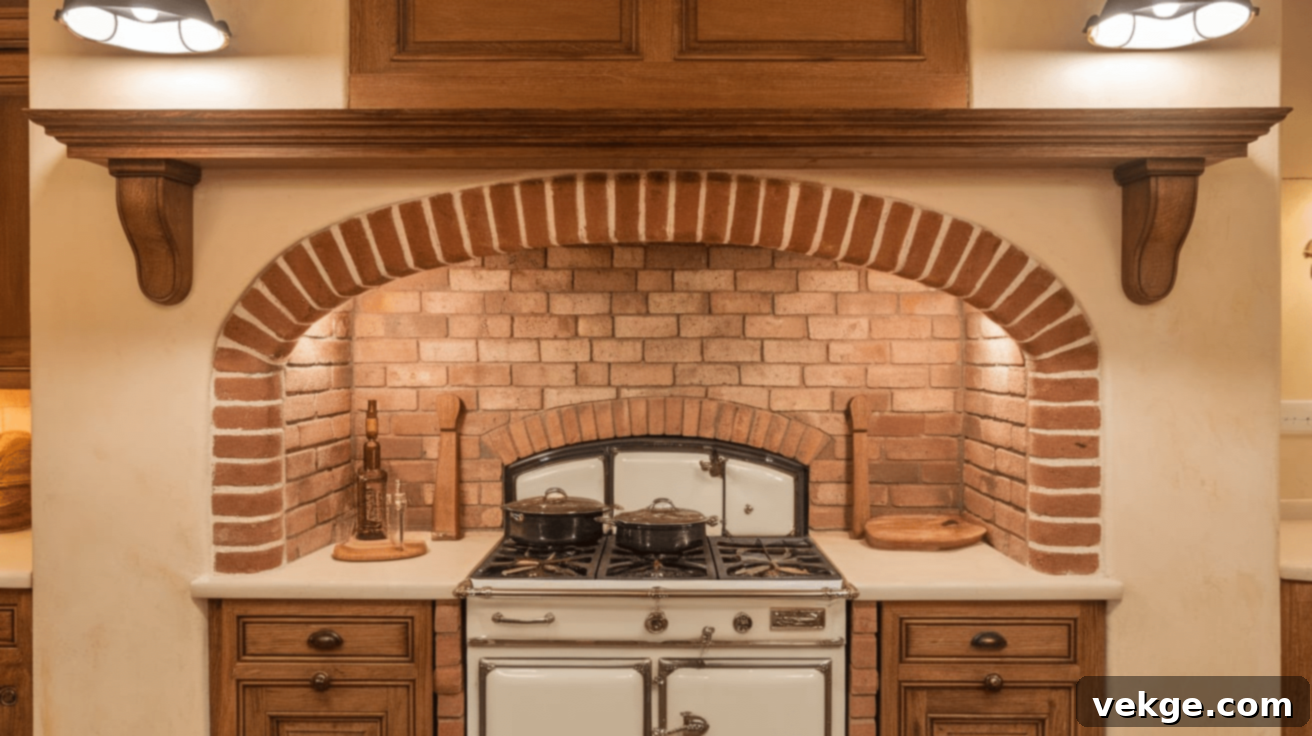
A traditional stove alcove draws inspiration from the enduring appeal of classic kitchens, often featuring materials that evoke a sense of history and permanence. These designs typically incorporate robust brick or natural stone surrounds, instantly infusing the space with a warm, inviting, and established feel. Arched designs are a hallmark of traditional alcoves, adding a graceful, architectural touch that harkens back to older European kitchens. To complete this timeless look, a substantial wooden mantel is often integrated above the stove, providing both a decorative shelf for cherished items and a practical spot for small kitchen tools. This style is an excellent choice for kitchens aiming for a cozy, time-honored, and sophisticated ambiance.
2. Modern Minimalist Stove Alcove: Sleek Simplicity
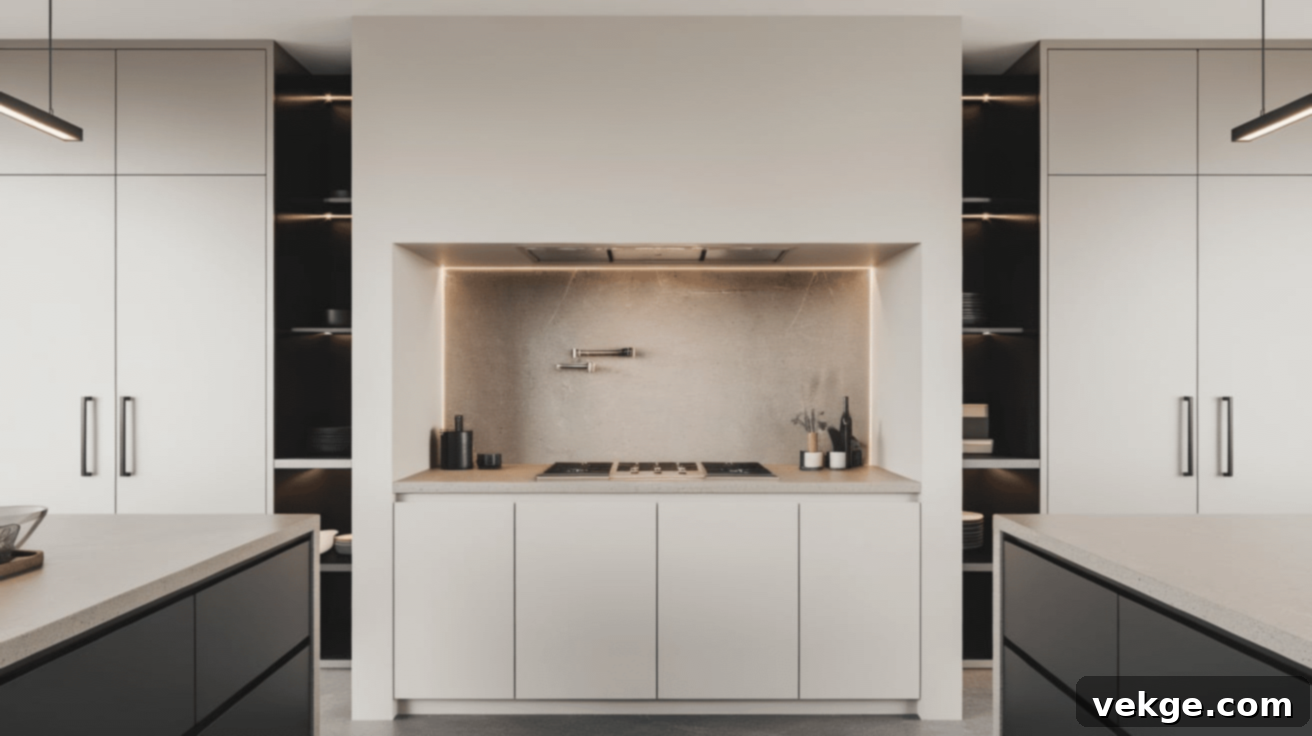
For those who favor clean lines, uncluttered spaces, and understated elegance, a modern minimalist stove alcove is the perfect solution. These designs prioritize sleek aesthetics and seamless integration, often featuring straight edges and a simple, box-like recessed shape that contributes to an overall sense of calm and order. Instead of ornate detailing, the focus is on smooth, polished finishes, often achieved with large-format or subway tile backsplashes in neutral tones. Many modern alcoves cleverly conceal the range hood, blending it seamlessly into the structure for an uninterrupted, streamlined appearance. This style thrives in contemporary kitchens where simplicity, functionality, and a refined aesthetic are paramount.
3. Farmhouse-Inspired Stove Alcove: Rustic Charm and Comfort

A farmhouse-style stove alcove is designed to bring a heartwarming blend of rustic charm and welcoming comfort into the kitchen. These alcoves frequently feature white or soft, neutral-colored cabinetry surrounding the stove, creating a light and airy yet cozy atmosphere. Textured elements are key, with materials like shiplap paneling, reclaimed wood accents, or beadboard adding character and a handcrafted feel. This style beautifully complements vintage-inspired ranges or classic cast-iron stoves, enhancing the nostalgic appeal and completing the authentic farmhouse look. The harmonious combination of natural materials and inviting color palettes makes this alcove feel genuinely rustic, personal, and profoundly inviting.
4. Luxury Stove Alcove with Statement Features: High-End Sophistication
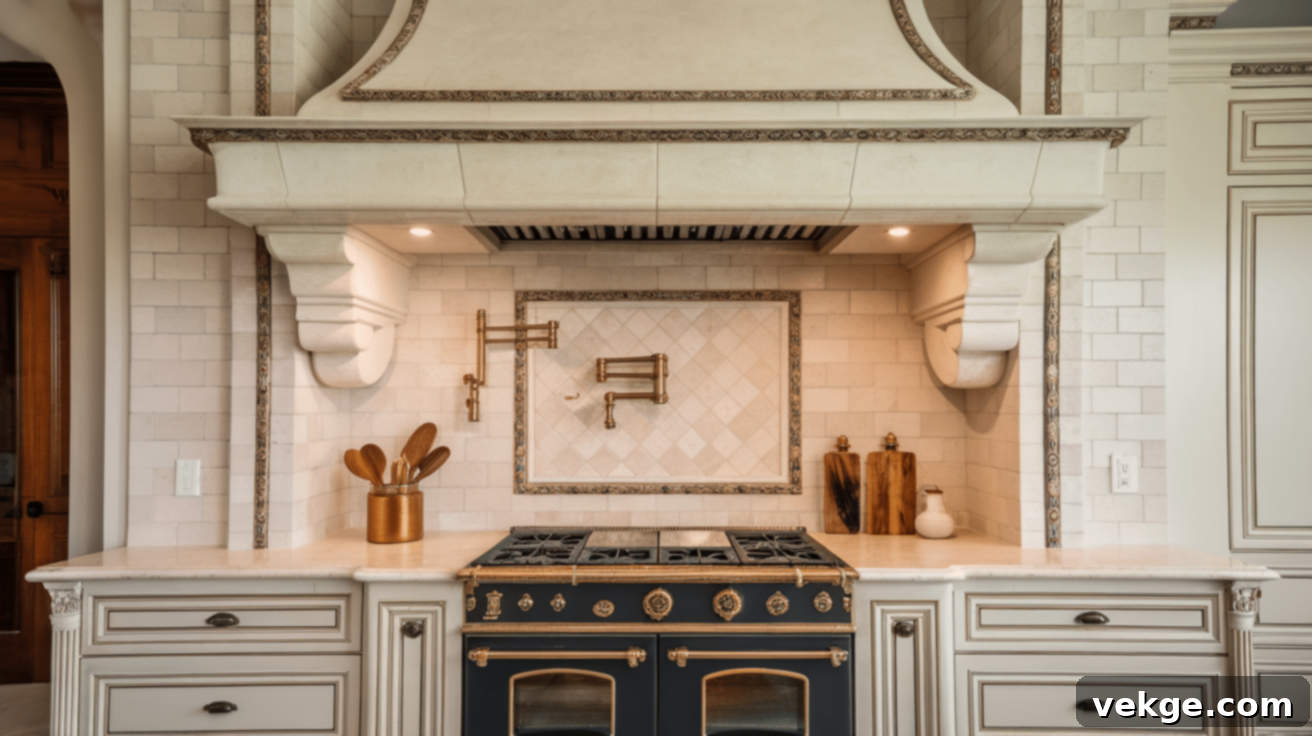
For homeowners aiming to infuse their kitchen with an undeniable sense of opulence and high-end design, a luxury stove alcove is the ultimate choice. These alcoves are distinguished by the use of premium materials such as exquisite marble, polished quartz, or bespoke, hand-painted tile designs, transforming the cooking area into a breathtaking focal point. Grand, decorative vent hoods often become a central part of the design, making an impressive statement. To further enhance the sophisticated ambiance, subtle, integrated lighting, such as under-cabinet or recessed alcove lighting, can be added, creating a warm glow that highlights the exquisite materials and craftsmanship. This style is perfectly suited for kitchens where beauty, superior quality, and a refined aesthetic are paramount, offering a truly bespoke and elegant cooking experience.
Designing a Stove Alcove for Optimal Functionality and Style
A successful stove alcove seamlessly blends aesthetic appeal with practical utility. When planning your alcove, meticulous attention to detail regarding size, material selection, storage integration, and ventilation is crucial to creating a space that is not only visually stunning but also safe, efficient, and enjoyable for cooking.
1. Choosing the Right Dimensions and Size
The dimensions of your stove alcove are paramount. It should perfectly frame your stove without feeling restrictive or overly expansive. An alcove that is too confined can lead to poor air circulation, heat buildup, and an uncomfortable cooking experience, while also making cleaning cumbersome. Conversely, an overly wide or tall alcove might diminish the desired visual impact and lose its defining character. Carefully measure your stove’s width, depth, and height, ensuring there’s adequate clearance for safe operation, proper ventilation, and easy access for cleaning and maintenance. A thoughtfully sized alcove strikes a harmonious balance between robust functionality and captivating design.
2. Selecting Heat-Resistant and Durable Materials
Given the high temperatures generated by a stove, the materials used for your alcove must be inherently heat-resistant and exceptionally durable. Ideal choices include classic brick, natural stone, and various types of fire-resistant tiles (such as ceramic, porcelain, or terracotta). These materials not only provide essential protection for the surrounding structure but also introduce rich texture, color, and character to the design. It’s crucial to avoid materials that are prone to warping, cracking, or discoloring when exposed to heat, such as untreated wood, certain plastics, or low-quality paints. If wood or painted finishes are desired, ensure they are situated at a safe, manufacturer-recommended distance from direct heat sources and are properly treated for heat exposure.
3. Integrating Practical Storage Solutions
A truly effective stove alcove goes beyond aesthetics by incorporating smart, practical storage. Think about adding built-in shelves, recessed cubbies, or pull-out racks on the sides of the alcove to keep spices, cooking oils, and frequently used utensils within immediate reach. This strategic placement significantly enhances cooking efficiency and maintains an uncluttered workspace. For maximizing space in smaller kitchens or achieving a minimalist look, consider hidden compartments or overhead shelving discreetly integrated into the alcove’s design. Easy access to cooking essentials transforms the alcove into a powerhouse of both functionality and style.
4. Prioritizing Optimal Ventilation
Proper airflow and ventilation are absolutely non-negotiable in a stove alcove. An effective ventilation system is vital for removing smoke, grease, steam, and excess heat, thereby preventing odors from lingering, protecting kitchen surfaces, and ensuring a comfortable and healthy cooking environment. A powerful, well-integrated range hood is the cornerstone of good ventilation. Design choices can range from sleek, concealed vents that blend seamlessly into the alcove structure to striking decorative hoods that become a design feature in themselves. It is essential to ensure the ventilation system is adequately sized for your stove and properly positioned to effectively capture and exhaust cooking fumes, keeping your kitchen air fresh and clean.
By thoughtfully considering these four critical aspects—size, materials, storage, and ventilation—you can create a stove alcove that is not just a beautiful design statement but also an incredibly practical and efficient cooking hub in your kitchen.
Common Mistakes to Avoid When Creating a Stove Alcove
While a stove alcove can undoubtedly enhance your kitchen’s style and functionality, certain missteps during planning and construction can lead to safety hazards, diminished comfort, or an aesthetically disappointing result. Being aware of these common pitfalls can help ensure your alcove project is a resounding success.
1. Overcrowding the Space Around the Stove
One of the most frequent errors is designing an alcove that is too small or too tightly frames the stove. This restriction can severely limit movement, making cooking feel cramped and uncomfortable. Insufficient clearance also hinders effective cleaning, allowing grease and food particles to accumulate in hard-to-reach areas. More critically, an overcrowded alcove can trap heat, potentially leading to overheating of the appliance or surrounding materials, posing safety risks. To prevent this, always ensure there is ample clearance on all sides of the stove, allowing for comfortable use, proper heat dissipation, and easy maintenance.
2. Neglecting Proper Ventilation Requirements
Underestimating or ignoring the need for robust ventilation is a significant and potentially hazardous mistake. Without an adequately powerful and correctly installed range hood, smoke, steam, grease, and excessive heat will accumulate, making the kitchen unpleasant and potentially damaging surfaces over time. Some homeowners choose a ventilation system that is too weak for their cooking habits or fail to position it correctly above the stove. Always invest in a high-quality, appropriately sized range hood that effectively captures and exhausts cooking fumes, ensuring a fresh, safe, and comfortable kitchen environment.
3. Using Non-Heat-Resistant Materials
The materials chosen for the stove alcove must be capable of withstanding high temperatures without degradation. Selecting materials that are not heat-resistant is a costly mistake, as they will quickly warp, discolor, crack, or even pose a fire risk over time, necessitating expensive repairs or replacements. Materials such as untreated wood paneling, low-quality paints, or certain plastic laminates are entirely unsuitable for areas exposed to direct heat. Always opt for inherently heat-resistant surfaces like brick, natural stone, ceramic or porcelain tile, or fire-rated finishes to ensure both the durability and safety of your alcove.
4. Insufficient Counter Space Around the Stove
A common oversight is failing to allocate enough usable counter space immediately adjacent to the stove within or around the alcove. Without sufficient landing zones for hot pots and pans, cutting boards, and meal prep ingredients, cooking can become cumbersome and frustrating. This lack of convenient workspace forces cooks to constantly reach for distant surfaces, disrupting workflow and potentially compromising safety. When designing your alcove, prioritize ample, easily accessible counter space on both sides of the stove to ensure a seamless, efficient, and enjoyable cooking experience.
Stunning Stove Alcove Inspiration from Real Homes
A stove alcove has the remarkable ability to transform a kitchen, adding layers of charm, character, and undeniable functionality. From timeless classic brick designs to sleek, modern minimalist styles, alcoves can be tailored to perfectly complement nearly any kitchen theme. Below, we explore inspiring real-life design ideas that showcase how homeowners have masterfully utilized this enduring kitchen feature, bringing their unique visions to life.
Classic & Traditional Designs: Timeless Elegance

Classic stove alcoves are renowned for their ability to infuse a kitchen with old-world charm and a sense of established elegance. Many of these designs feature beautifully crafted arched brickwork or natural stone surrounds that gracefully frame the stove, creating a warm, inviting, and architecturally significant space. Vintage-style stoves, with their iconic designs and robust build, fit seamlessly within these alcoves, further enhancing the historic and cozy atmosphere. Homeowners undertaking kitchen renovations often strive to preserve original alcove structures in older properties, updating them with durable, heat-resistant tiles on the interior while maintaining the authentic brick or stone exterior to honor the home’s heritage. These traditional alcoves are perfectly suited for homes that seek to cultivate a timeless, sophisticated, and deeply comfortable kitchen ambiance.
Modern & Minimalist Stove Alcoves: Sleek and Uncluttered
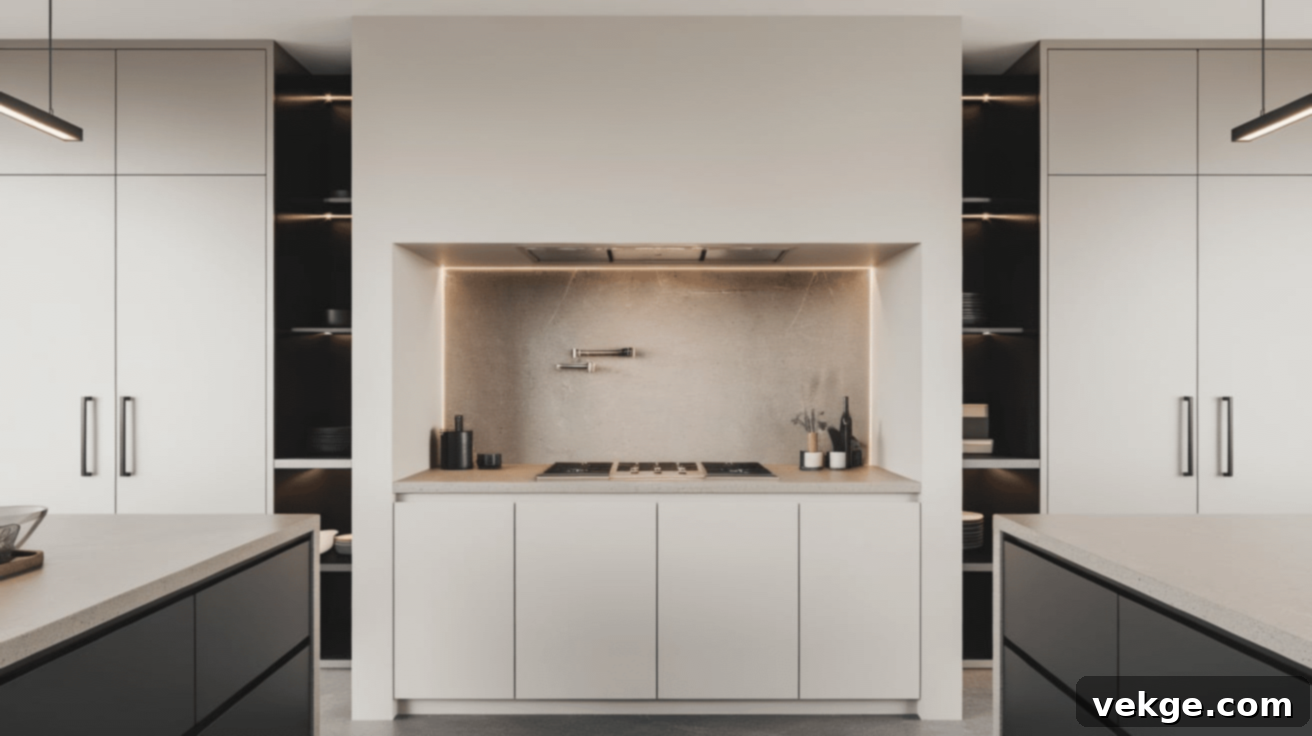
For those who covet a clean, uncluttered, and highly sophisticated aesthetic, modern and minimalist stove alcoves are an increasingly popular choice. These designs often highlight sleek, built-in alcoves that integrate concealed storage solutions, ensuring every item has its place and the space remains impeccably tidy. The strategic use of monochromatic color schemes, such as matte black, crisp white, or soft grays, helps the alcove blend harmoniously and seamlessly with the overall kitchen design, creating a sense of understated luxury. Minimalist alcoves frequently feature simple yet elegant tilework, perhaps large format tiles, classic subway tiles, or neutral-colored natural stone. A common feature is the use of hidden or integrated range hoods, which allows the alcove to maintain its smooth, uninterrupted visual flow. These designs are ideal for contemporary kitchens that prioritize simplicity, high functionality, and a bold, streamlined statement.
Farmhouse & Cottage-Style Stove Alcoves: Warm and Welcoming
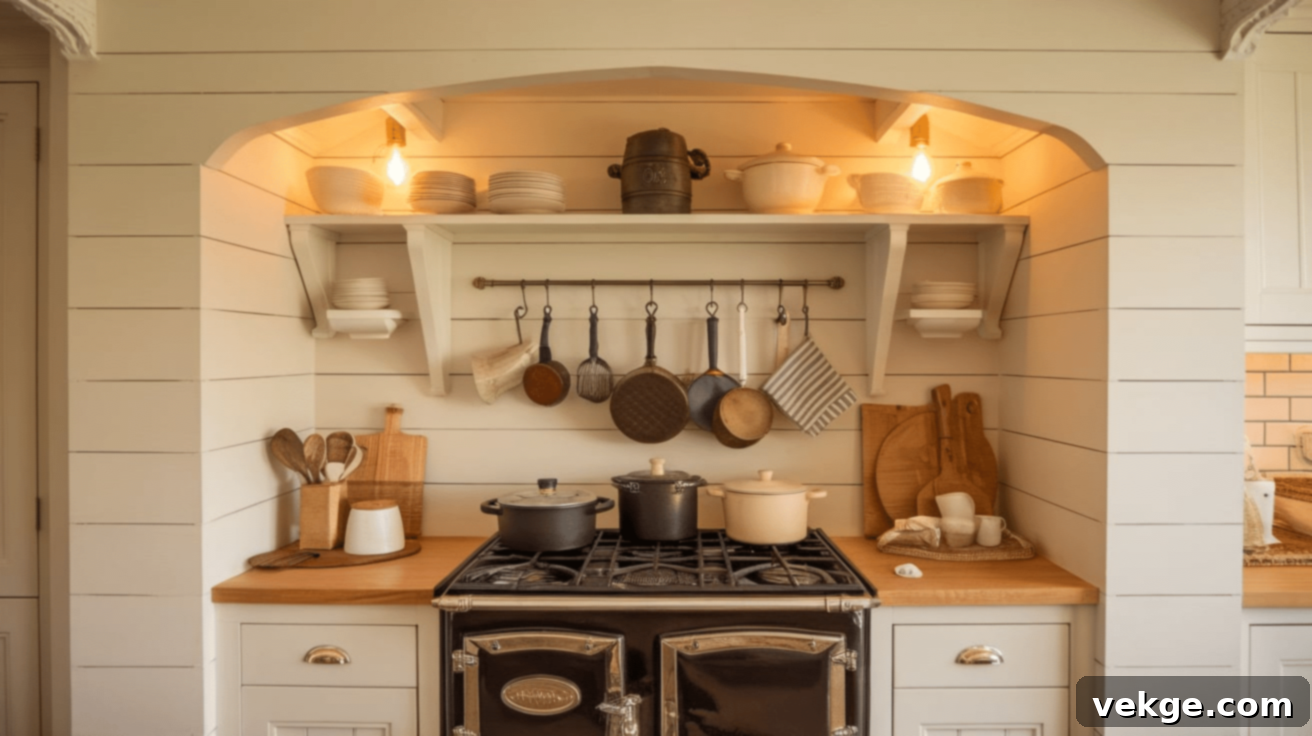
A farmhouse or cottage-style stove alcove is designed to infuse the kitchen with an abundance of warmth, character, and an irresistible cozy appeal. These inviting designs frequently incorporate textural elements like shiplap walls, exposed wooden beams, and charming rustic decor, all contributing to a relaxed and welcoming atmosphere. Many farmhouse alcoves pair beautifully with vintage-inspired appliances, such as classic cast-iron stoves or retro-style ranges, which enhance the nostalgic feel and authentic aesthetic. These designs celebrate natural materials, soft, muted color palettes, and often include thoughtful details like open shelving or antique hooks, perfect for displaying favorite pots, pans, and utensils, blending both style and highly accessible function into a truly personal space.
High-End Custom Stove Alcoves: Ultimate Luxury and Bespoke Design
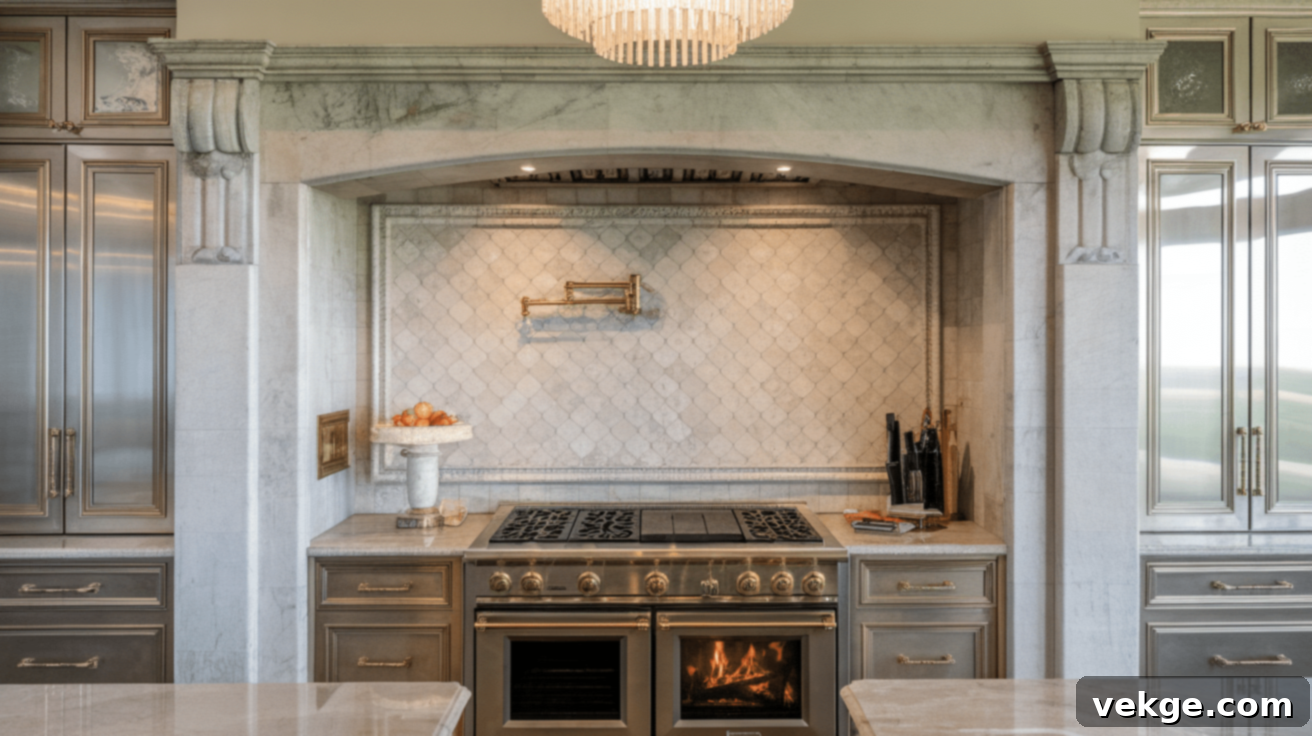
For discerning homeowners seeking to create an unparalleled sense of luxury and bespoke design in their kitchen, high-end custom stove alcoves offer an exquisite finish. These upscale designs are distinguished by the use of premium materials, such as opulent slabs of marble or quartz, intricate custom tilework, or unique artisanal finishes, ensuring the alcove becomes a true masterpiece and the absolute centerpiece of the kitchen. Luxury stove alcoves frequently integrate sophisticated built-in lighting, such as discreet LED strips or elegant sconces, which artfully highlight the stove area and add a warm, inviting glow to the entire space. High-end fixtures, often in lustrous gold, antique brass, or polished chrome, further elevate the design, creating a refined and polished look. Custom cabinetry meticulously crafted around the alcove often provides hidden, seamless storage solutions, maintaining the kitchen’s pristine appearance and undeniable style.
Step-by-Step Guide to Building a Stove Alcove in Your Kitchen
Adding a stove alcove can significantly enhance both the visual appeal and functional efficiency of your kitchen. However, achieving a successful result requires careful planning and execution. This step-by-step guide will walk you through the essential stages of creating an alcove that perfectly suits your space and culinary needs.
1. Thorough Planning and Design Conceptualization
Before any construction begins, dedicate ample time to planning your alcove’s design. This initial phase is crucial for ensuring the final result is both beautiful and practical. Consider:
- Dimensions: Precisely determine the size and depth of the alcove based on your chosen stove’s dimensions and the available kitchen space. Account for necessary clearances for safety and ventilation.
- Style Integration: Decide on the aesthetic—will it be traditional, modern, farmhouse, or luxury? Ensure the alcove’s design harmonizes with your kitchen’s overall theme and existing cabinetry.
- Material Selection: Research and choose materials that align with your desired style while also ensuring durability and heat resistance, as discussed in previous sections.
2. Selecting the Perfect Stove
The stove is the heart of the alcove, so its selection is paramount. Choose an appliance that not only meets your cooking needs but also fits perfectly within the planned alcove structure. Keep in mind:
- Size Compatibility: The width, depth, and height of your stove must allow for comfortable use and easy cleaning within the alcove’s confines.
- Clearance Requirements: Consult the stove manufacturer’s guidelines for specific clearance distances from combustible materials and proper ventilation needs.
- Type and Power: If opting for a vintage, specialty, or professional-grade stove, verify its size, weight, and power requirements (gas lines, electrical outlets) before finalizing your design.
3. Installing an Efficient Ventilation System
Effective airflow is non-negotiable for a safe and comfortable stove alcove. Selecting and properly installing a robust vent hood is a critical step:
- Aesthetics vs. Function: Decide whether you want a concealed vent hood for a seamless, minimalist look or a decorative, statement-making hood that complements the alcove’s design.
- Extraction Power: Choose a vent hood with sufficient CFM (Cubic Feet per Minute) to effectively remove heat, grease, and smoke generated by your cooking habits.
- Integration: Ensure the vent hood fits ergonomically within the alcove structure, allowing for optimal capture of fumes without obstructing views or accessing storage.
4. Choosing and Applying Robust Materials
The materials used for the alcove’s construction must be capable of withstanding the heat and moisture inherent in a cooking environment. Ideal choices include:
- Brick or Stone: Excellent for a durable, rustic, or traditional look. These materials offer inherent heat resistance and a timeless aesthetic.
- Fire-Resistant Tile: Ceramic, porcelain, or natural stone tiles provide a stylish, easy-to-clean, and highly protective finish.
- Treated Wood or Heat-Resistant Paint: If a framed or painted design is desired, ensure all wood is properly treated and paints are high-temperature rated, and always maintain safe distances from direct heat sources.
5. Incorporating Smart Storage Features
Maximize the functionality of your alcove by thoughtfully integrating storage solutions that keep essentials organized and accessible:
- Spice Racks: Install narrow shelves or pull-out spice racks on the interior sides of the alcove for quick and easy access during cooking.
- Hidden Compartments: Consider flush-mounted doors or drawers for utensils, cutting boards, or less frequently used cookware to maintain a clean aesthetic.
- Overhead or Side Shelving: Floating shelves above or beside the stove can provide additional space for cookbooks, decorative items, or frequently used ingredients without cluttering the main workspace.
6. Adding Refined Final Touches
Once the core construction is complete, the final touches will elevate the alcove from a functional space to a truly polished design feature:
- Decorative Lighting: Install under-shelf lighting, recessed spotlights, or elegant sconces within the alcove to highlight the stove area and add warmth.
- Stylish Backsplash: Beyond the alcove’s internal materials, extend a complementary backsplash to surrounding walls for continuity and added protection.
- Trim and Molding: Add decorative trim or molding that matches or complements the rest of your kitchen’s architectural details, creating a cohesive and finished look.
By diligently following these steps, you can successfully build a stove alcove that not only serves as a practical cooking hub but also stands as a stunning design statement in your kitchen.
Cost Considerations and Budget-Friendly Stove Alcove Ideas
A stove alcove offers remarkable flexibility in terms of budget. It can be a simple, cost-effective enhancement or a grand, custom-built feature, depending heavily on your material selections, design complexity, and whether you opt for professional installation or a DIY approach. Understanding the financial implications associated with each choice is key to making informed decisions and keeping your project within a comfortable budget.
Typical Costs for a Custom Stove Alcove
The investment required for building a stove alcove varies significantly based on the level of customization, the quality of materials, and the labor involved. Here’s a breakdown of what you might expect:
Budget-Friendly Options
For those looking to add the charm of an alcove without breaking the bank, costs can range from $500 to $1,500. This typically includes:
- Affordable Backsplash: Utilizing easy-to-install, cost-effective options like peel-and-stick tiles or basic ceramic tiles for a stylish yet economical finish.
- Standard Ventilation: Opting for a prefabricated or builder-grade vent hood instead of a custom-built, integrated system.
- Simple Storage: Incorporating low-cost storage solutions such as basic wooden shelves, metal racks, or repurposed existing cabinet space for spices and utensils.
- DIY Labor: Undertaking much of the installation work yourself can significantly reduce labor costs.
Mid-Range Build
A well-designed alcove featuring upgraded materials and some custom elements typically falls within the range of $2,000 to $5,000. This category often includes:
- Quality Tile Work: Using higher-quality ceramic, porcelain, or subway tiles for the backsplash and interior alcove lining.
- Semi-Custom Framing: Incorporating custom or semi-custom cabinetry and framing elements around the stove to create the alcove effect, often professionally installed.
- Improved Ventilation: Investing in a more powerful and efficiently integrated ventilation system that offers better performance and quieter operation.
- Partial Professional Help: Hiring professionals for specific tasks like tiling or electrical work.
High-End Custom Alcove
For a fully bespoke, architecturally integrated alcove with premium materials and finishes, costs can range from $6,000 to $15,000+. This high-end investment typically covers:
- Luxury Materials: Embellishing the alcove with exquisite materials such as custom-cut marble, high-grade quartz, hand-painted artisanal tiles, or unique natural stone.
- Integrated Custom Cabinetry: Designing and installing fully custom cabinetry that seamlessly blends the alcove with the rest of the kitchen, often involving intricate millwork.
- Advanced Lighting & Features: Implementing built-in, dimmable lighting features, specialized fixtures, and potentially smart home integrations for both aesthetics and functionality.
- Structural Modifications: Significant structural changes to create arched recesses, false walls, or unique architectural forms.
- Professional Design & Installation: Engaging experienced designers and skilled craftsmen for every stage of the project.
Affordable Upgrades for Any Stove Alcove
Even with a modest budget, there are numerous creative ways to enhance the visual appeal and functionality of your stove alcove without overspending:
- Peel-and-Stick Tile Backsplashes: An incredibly cost-effective and DIY-friendly alternative to expensive stone or ceramic tile, offering a wide range of styles.
- Repurposing Existing Cabinetry: Instead of building an entirely new structure, strategically use or modify existing surrounding cabinets to create a recessed alcove effect.
- Heat-Resistant Paint or Stencils: For a personalized touch, use high-temperature paint in a bold color or apply a stencil pattern to the alcove’s interior for added depth and texture instead of tiling.
- DIY Open Shelving: Install floating shelves made from reclaimed wood, budget-friendly lumber, or simple metal racks to provide accessible storage without the high cost of custom built-ins.
Where to Save & Where to Splurge for Value
Making smart decisions about where to economize and where to invest can significantly impact your project’s overall value and longevity:
Save On:
- Backsplash Materials: Opt for more affordable ceramic or subway tiles instead of premium natural stone or intricate mosaic designs. Painted finishes are also a budget-conscious choice.
- Ventilation Aesthetics: A good mid-range vent hood often provides excellent functionality at a fraction of the cost of a designer model. Prioritize performance over brand name for standard use.
- Storage Solutions: Simple wall-mounted racks, floating shelves, or off-the-shelf organizers are far less expensive than bespoke, integrated cabinetry.
Splurge On:
- Durable, Heat-Resistant Core Materials: Invest in high-quality brick, stone, or fire-resistant tiles for the critical internal structure of the alcove. These materials ensure safety, longevity, and better heat management.
- Integrated Lighting: Well-placed under-shelf or alcove lighting significantly enhances ambiance, improves visibility, and makes the space feel more sophisticated.
- Professional Installation (for structural changes): If your alcove design involves structural modifications to walls or gas/electrical lines, hiring qualified professionals is a splurge that ensures safety, compliance, and prevents costly errors in the long run.
By balancing these cost considerations wisely, homeowners can achieve a beautiful, functional, and safe stove alcove that perfectly fits their vision and nearly any budget.
Conclusion: Elevate Your Kitchen with a Stove Alcove
A stove alcove is much more than a simple kitchen feature; it’s a transformative design element that brings together both practicality and undeniable aesthetic charm. By providing a dedicated, organized cooking space, it significantly improves heat control, offers invaluable built-in storage solutions, and most importantly, establishes your stove as the captivating focal point of your kitchen.
With an incredible range of design choices available, a stove alcove can be meticulously tailored to complement any kitchen style, from the sleek lines of modern minimalism to the comforting warmth of farmhouse rustic, or the timeless elegance of traditional designs. The key to a successful alcove lies in thoughtful planning: prioritizing heat-resistant materials for safety and durability, ensuring proper ventilation for a comfortable cooking environment, and integrating smart storage solutions for maximum efficiency.
Regardless of your personal style preference or kitchen size, a well-designed stove alcove seamlessly blends sophisticated style with everyday convenience. It not only boosts the overall efficiency of your kitchen workflow but also creates a warm, inviting, and highly personalized culinary space that truly reflects your taste. By investing careful thought and planning into its creation, a stove alcove has the power to transform your kitchen into a haven that is both exceptionally practical and strikingly beautiful, making every cooking experience a pleasure.
Frequently Asked Questions About Stove Alcoves
What is the standard size for a stove alcove?
While there isn’t a universally “standard” size, most stove alcoves are designed to accommodate standard range widths, typically ranging from 30 to 48 inches wide. The depth usually matches or slightly exceeds the stove’s depth. It’s crucial to leave adequate clearance (at least 1-3 inches on each side and above) for proper ventilation, safe operation, and ease of cleaning. Custom sizes are always an option and should be tailored based on your specific stove dimensions, kitchen layout, and design preferences to ensure a perfect fit and functional flow.
Do you need a special vent hood for a stove alcove?
Yes, proper ventilation is absolutely essential within a stove alcove. You will need a range hood that is adequately sized and powerful enough for your cooking needs, and it must be correctly installed to effectively remove smoke, steam, grease, and excess heat. While not necessarily “special,” the hood needs to be appropriate for the alcove’s dimensions and integrated either visibly as a design feature or discreetly concealed within the alcove structure to maintain the desired aesthetic. This ensures a safe, clean, and comfortable cooking environment.
What materials work best for a stove alcove?
The best materials for a stove alcove are those that are durable, easy to clean, and, most importantly, highly heat-resistant. Excellent choices include traditional brick, natural stone (like granite or marble), and various types of fire-resistant tiles (such as ceramic, porcelain, or terracotta). These materials can withstand high temperatures and contribute significantly to the alcove’s style. It’s crucial to avoid materials that are prone to warping, discoloring, or cracking when exposed to heat, such as untreated wood or certain plastics.
Can I build a stove alcove in a small kitchen?
Absolutely! A stove alcove can be a fantastic addition to a small kitchen. The key is thoughtful design and space optimization. In smaller kitchens, you can opt for a compact alcove with minimal framing, integrating space-saving features like built-in, shallow shelving or hidden storage. Using light-colored materials can help the space feel larger, and a streamlined, minimalist approach can prevent the alcove from overwhelming the room. A well-designed compact alcove can actually make a small kitchen feel more organized and purposeful without sacrificing valuable space.
